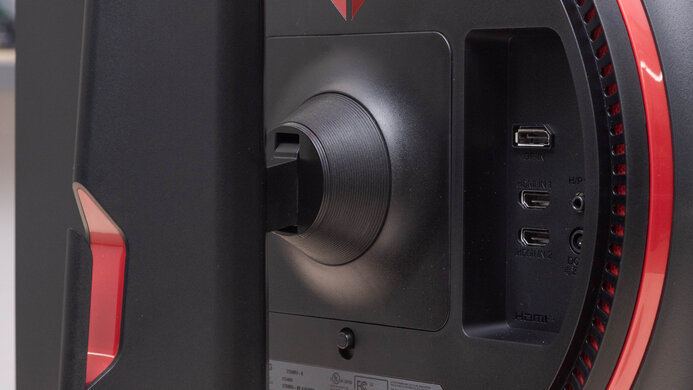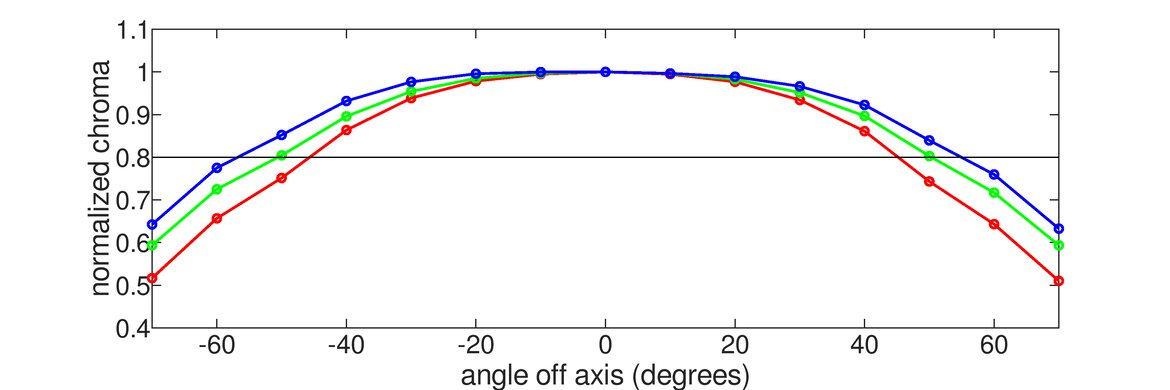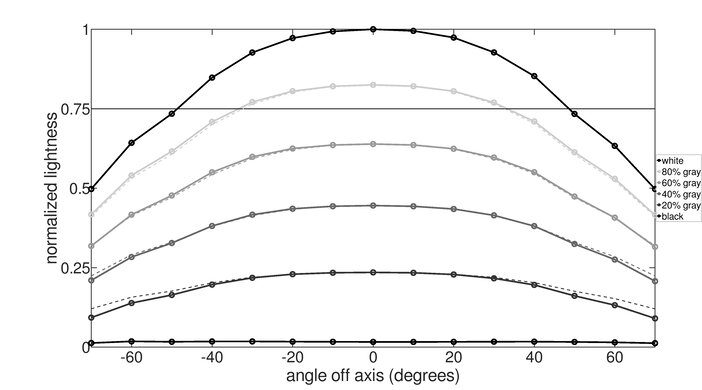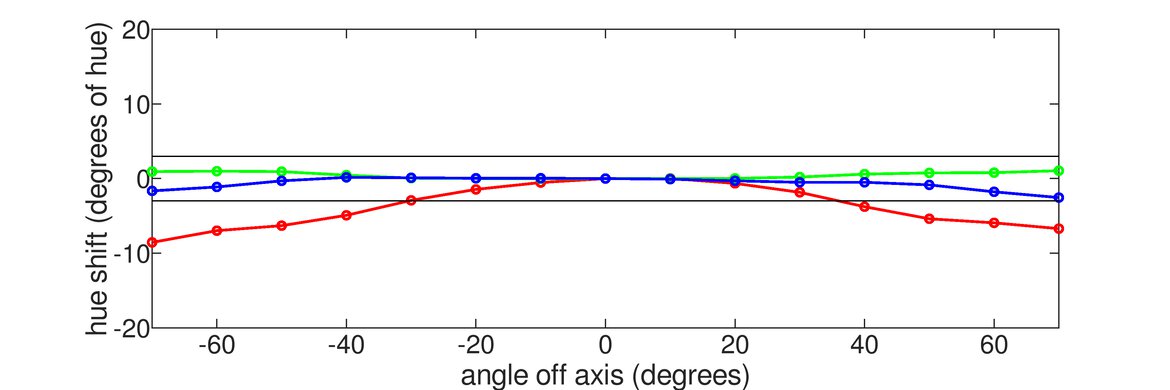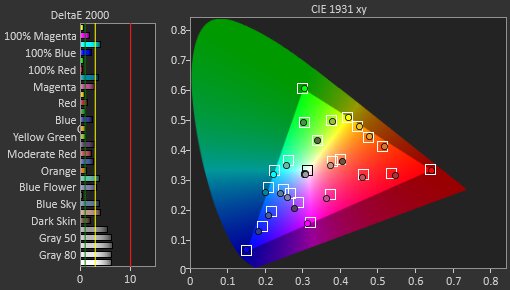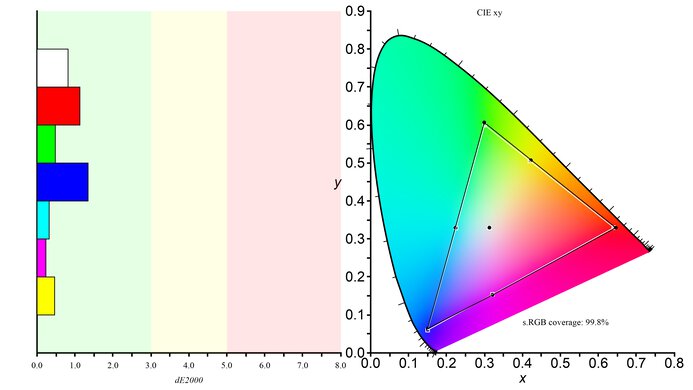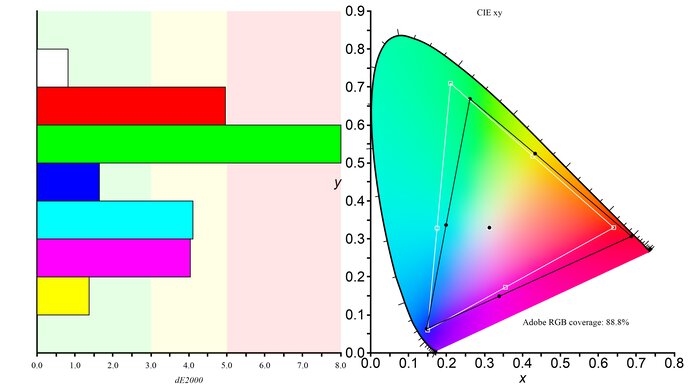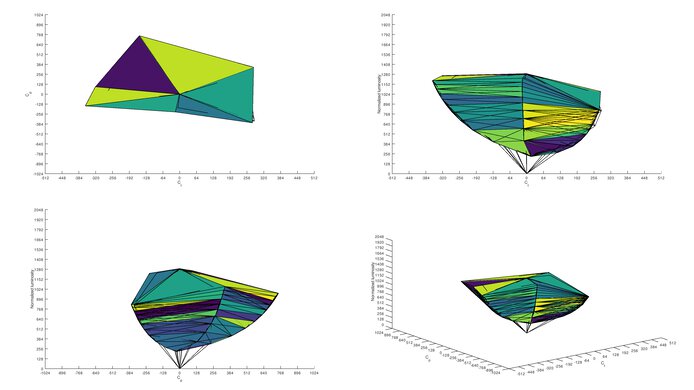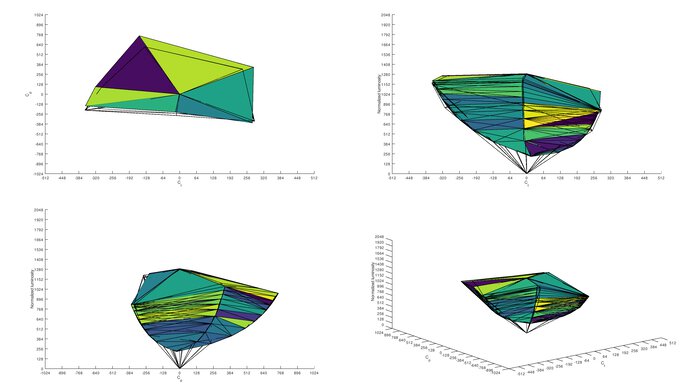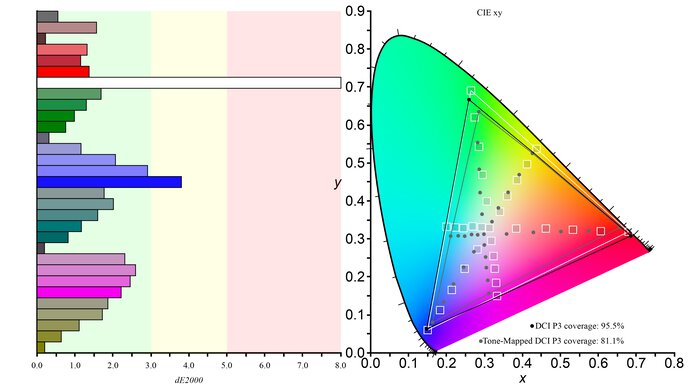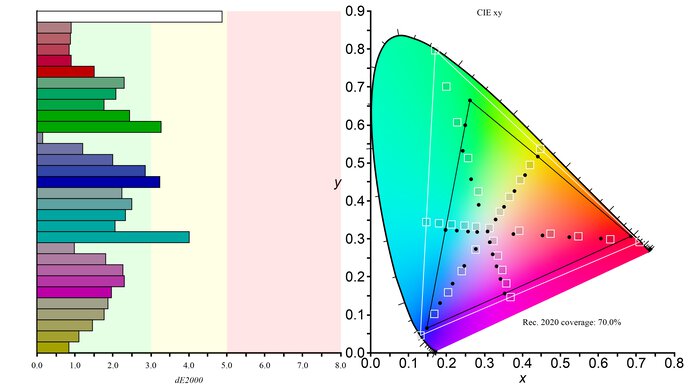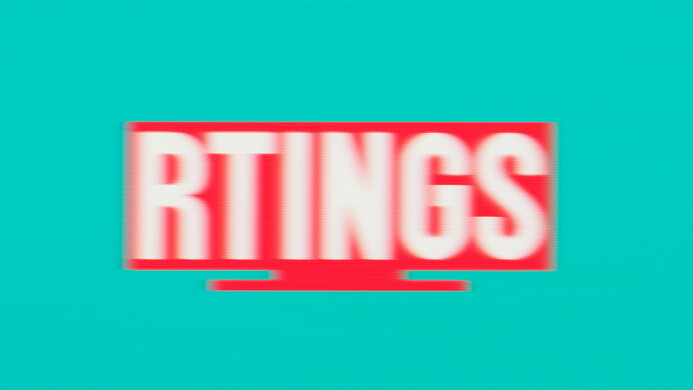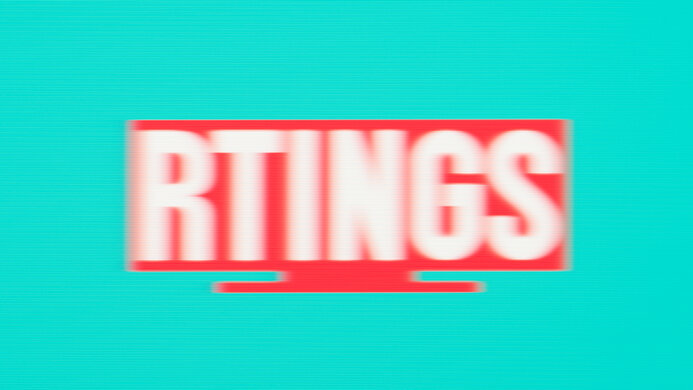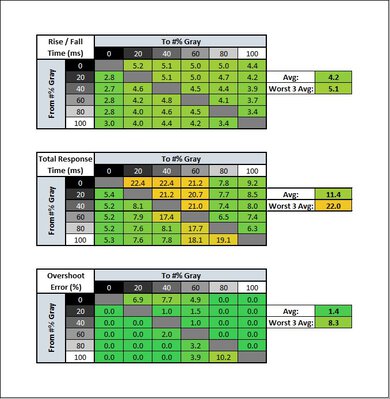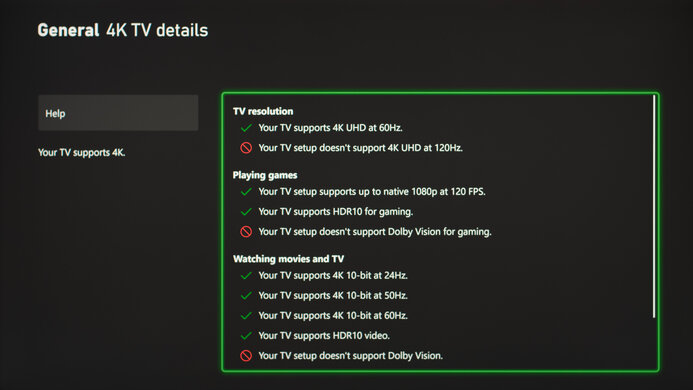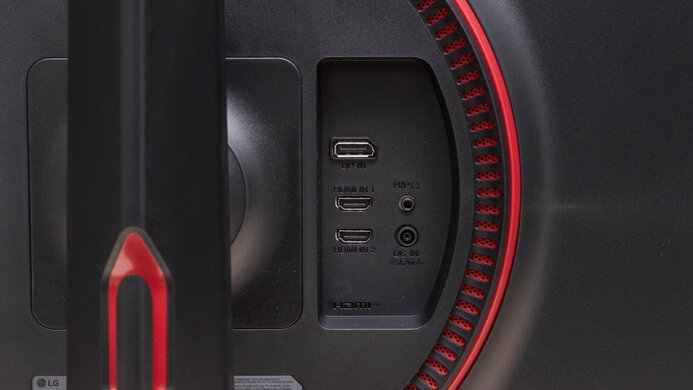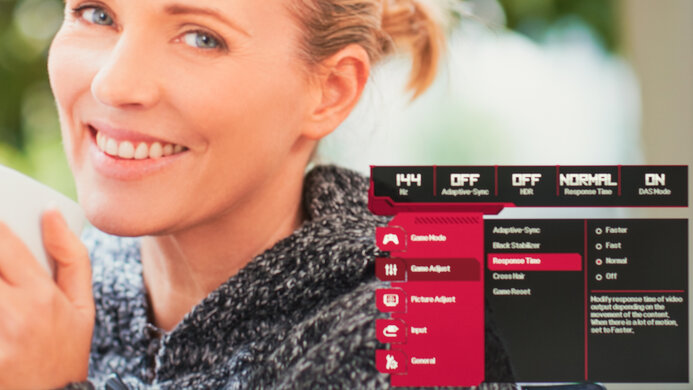The LG 27GN850-B/27GN880-B is an impressive gaming monitor. It replaces the LG 27GL850-B/27GL83A-B and is an overall improvement. Gamers should appreciate the incredible response time at its max refresh rate of 144Hz, resulting in minimal motion blur, and it remains fast when gaming at 60Hz. It supports Adaptive Sync and is compatible with both FreeSync and G-SYNC to reduce screen tearing, and the input lag is also incredibly low. It has a large 27-inch screen with a 1440p resolution, which helps deliver an immersive gaming experience without being too heavy on your graphics card. It has an IPS panel with wide viewing angles, so the image remains accurate when viewing from the side. However, that comes at the cost of a low contrast ratio, and without local dimming, blacks appear gray when viewed in the dark.
Our Verdict
The LG 27GN850-B is very good overall. It offers impressive gaming performance because it has a high 144Hz refresh rate with VRR support, the response time is incredible, and input lag is extremely low. Its 27 inch, 1440p screen makes it good for office use and content creators, and it has wide viewing angles if you need to share your screen with someone else. Sadly, it has a low contrast ratio and lacks local dimming, so blacks appear closer to gray when viewed in the dark.
- Wide viewing angles.
- High 144Hz refresh rate and VRR support.
- Extremely low input lag.
- Incredible response time.
- Disappointing ergonomics.
- Low contrast ratio.
The LG 27GN850-B is good for office use. Its 27 inch screen size allows you to open multiple windows at once, and its 1440p resolution delivers clear text. It has wide viewing angles, making it easier to share your screen with others. However, it has disappointing ergonomics as you can't swivel it. Lastly, reflection handling is decent, and it gets bright enough to fight glare in well-lit rooms.
- Wide viewing angles.
- Good peak brightness and decent reflection handling.
- Large screen and high resolution.
- Disappointing ergonomics.
- Glare may be an issue in really well-lit rooms.
The LG 27GN850-B is impressive for gaming. It has an incredible response time whether you're gaming at its native 144Hz refresh rate or 60Hz, and the input lag is incredibly low. It has FreeSync and G-SYNC compatibility to reduce screen tearing. Sadly, it's not a good choice for dark room gaming because of its low contrast ratio and poor black uniformity.
- High 144Hz refresh rate and VRR support.
- Extremely low input lag.
- Incredible response time.
- Low contrast ratio.
- No local dimming feature.
The LG 27GN850-B is good for consuming multimedia content. Its 1440p resolution helps deliver crisp images, and it has a large, 27 inch screen. It performs well in bright rooms thanks to its decent reflection handling and good peak brightness. However, it's not a good choice for dark rooms because it has a low contrast ratio that makes blacks appear closer to gray.
- Wide viewing angles.
- Good peak brightness and decent reflection handling.
- Large screen and high resolution.
- Disappointing ergonomics.
- Low contrast ratio.
The LG 27GN850-B is very good for content creators. The large screen and high resolution mean you can easily open multiple windows side-by-side, which is great for multitasking. It has wide viewing angles, so people viewing from the side get the same accurate image as if they would be directly in front. However, it has disappointing ergonomics, making it difficult to position your screen to share with someone.
- Wide viewing angles.
- Good peak brightness and decent reflection handling.
- Large screen and high resolution.
- Disappointing ergonomics.
- Low contrast ratio.
The LG 27GN850-B is mediocre for HDR. While it displays a wide range of colors, its overall HDR performance is limited because it doesn't get bright enough to make highlights stand out. It also has a low contrast that makes blacks look gray in the dark and lacks a local dimming feature to further improve it.
- Displays wide range of colors in HDR.
- Low contrast ratio.
- No local dimming feature.
- Mediocre HDR peak brightness.
Changelog
- Updated Dec 15, 2023: Clarified the differences between this monitor and its variant, the LG 27GN880-B, in the Variants section.
- Updated Feb 14, 2023: Added text in the macOS Compatibility and Console Compatibility boxes as part of Test Bench 1.2. Also changed the FreeSync result in Variable Refresh Rate to 'Yes'.
- Updated Feb 10, 2023: Updated to Test Bench 1.2, resulting in changes to the results and scores with the Response Time and Input Lag. Added tests for Console Compatibility and macOS compatibility and made minor changes to other tests, which you can see in our Changelog.
- Updated Jun 01, 2021: We mistakenly indicated the thickness with stand as 32.2 cm instead of 22.2 cm. It has been fixed.
Check Price
Differences Between Sizes And Variants
We reviewed the 27-inch LG 27GN850-B, which is also available at the LG 27GN880-B. While they use the same screen and perform the same, the 27GN880-B comes with LG's Ergo Stand. It's essentially a mounting arm that you attach to the edge of your desk, and it offers all kinds of ergonomic adjustments. You can see what it looks like here.
| Model | Size | Panel Type | Resolution | Refresh Rate | Ergonomics |
| LG 27GN850-B | 27" | IPS | 1440p | 144Hz | Height, Tilt, Rotate |
| LG 27GN880-B | 27" | IPS | 1440p | 144Hz | Height, Tilt, Rotate, Swivel, and Extend |
The unit we reviewed was manufactured in October 2020, and you can see the label here.
Popular Monitor Comparisons
The LG 27GN850-B is an impressive gaming monitor that has features most people should enjoy, such as VRR support, an incredible response time, and extremely low input lag. In terms of gaming, it's an improvement over the LG 27GL850-B/27GL83A-B, but if you need it for office use as well, it's lacking in ergonomics. There are similarly priced options with better ergonomics, like the Dell S2721DGF.
See our recommendations for the best 1440p 144Hz monitors, the best gaming monitors, and the best LG monitors.
The LG 27GN850-B/27GN880-B is a slight improvement over its predecessor, the LG 27GL850-B/27GL83A-B. The 27GN850-B displays wider SDR and HDR color gamuts, meaning it's a better choice for content creators. It also has a quicker response time at its max refresh rate, making it a slightly better choice for gaming. However, the 27GL850-B gets brighter and has better reflection handling, so it's a good choice for well-lit rooms. It also has two USB inputs, which the 27GN850-B doesn't have, so you can easily charge your devices while working.
The LG 27GP850-B/27GP83B-B is a bit better than the LG 27GN850-B/27GN880-B. The 27GP850 has a higher refresh rate, resulting in a faster response time and clearer motion. The 27GP850 also has an optional black frame insertion feature to reduce the appearance of persistence blur, but it's a bit limited and only works over a narrow refresh rate range. Finally, the 27GP850 has slightly better connectivity, with a built-in USB hub.
The MSI Optix MAG274QRF-QD is a bit better for most uses than the LG 27GN850-B/27GN880-B, but they have many of the same features. They both have outstanding response time and low input lag for gaming, but the MSI has a slightly higher 165Hz refresh rate. It also has a BFI feature, but it only works within a narrow range. However, the LG has better out-of-the-box accuracy, and colors don't look as over-saturated as the MSI, so you may not need to get it calibrated to enjoy it to the fullest.
The LG 27GN850-B/27GN880-B and the LG 27GN800-B are very similar monitors. They use an almost identical panel, but the 27GN800-B has a much simpler stand with practically no adjustment options. Unless the stand is a dealbreaker, the 27GN800-B may actually be the better choice. While most casual gamers may not notice, the 27GN800-B has a slightly faster response time and a lower 60Hz input lag. These are minor differences, but if you're going to mount your monitor, the 27GN800-B may represent a better value.

We buy and test more than 30 monitors each year, with units that we buy completely on our own, without any cherry-picked units or samples. We put a lot into each unbiased, straight-to-the-point review, and there's a whole process from purchasing to publishing, involving multiple teams and people. We do more than just use the monitor for a week; we use specialized and custom tools to measure various aspects with objective data-based results. We also consider multiple factors before making any recommendations, including the monitor's cost, its performance against the competition, and whether or not it's easy to find.
Test Results

The LG 27GN850-B has the same style as most of LG's UltraGear monitors from their 2020 lineup, such as the LG 27GN950-B. It has thin borders on three sides with a thicker bottom bezel. It's mainly black with red accents throughout. Unlike the LG 27GL850-B/27GL83A-B, the V-shaped feet don't sit flat on the desk and are a bit elevated. There's cable management through the stand, and overall it's a fairly well-built monitor.
The LG 27GN850-B's build quality is decent. It's similar to the LG 27GN950-B, and it's made entirely out of basic, plastic materials that feel solid. There aren't any obvious gaps or loose parts. The stand supports the screen well, and there isn't much wobble. However, the hook for cable management feels a bit flimsy, but this may only be a problem if you're constantly removing cables from it.
The ergonomics are decent. You can rotate the screen into portrait mode, but since you can only do it in the clockwise direction, the inputs are always on top. It could be an issue if you have short cables.
The back of the monitor has the same red ring found on most UltraGear monitors, but it doesn't light up. There's cable management through the hook in the stand.
The LG 27GN850 has a low contrast ratio, which is expected from an IPS panel. Blacks appear gray when viewed in the dark, and there's no local dimming feature to help improve it. This is lower than the advertised 1000:1 contrast, but it may vary between units.
The LG 27GN850-B doesn't have a local dimming feature. The above video is provided for reference only.
The LG 27GN850-B has good SDR peak brightness. It maintains its brightness extremely consistent across different content, and it gets bright enough to combat glare. However, this is lower than the advertised 350 cd/m². We measured peak brightness after calibration in the 'Gamer 1' Picture Mode with Brightness set to max.
The LG 27GN850 has mediocre HDR peak brightness. It only gets a bit brighter than in SDR, and highlights quickly lose their brightness the longer they stay on the screen. It's not enough to make highlights pop the way the creator intended in HDR. We measured the HDR peak brightness in the 'Gamer 2' Picture Mode.
The LG 27GN850 has an excellent horizontal viewing angle, which is normal for an IPS panel. The image remains accurate as you move off-center, which is great if you want to use it for co-op gaming.
The vertical viewing angle isn't bad. You may notice a loss in image accuracy if you mount the monitor above eye level.
The accuracy before calibration is great. It has an sRGB picture mode that locks the colors to the sRGB color space so that most web content doesn't look oversaturated. However, the white balance, color temperature, and gamma are still a bit off. Unfortunately, the sRGB mode locks many settings, including the Response Time and Black Stabilizer settings, so if you want to use those settings, you'll need to use the 'Gamer 1' mode that has oversaturated colors.
The LG 27GN850 has remarkable accuracy after calibration. Any remaining inaccuracies with white balance and most colors can't be spotted by the naked eye. Gamma follows the target curve very well, and the color temperature is extremely close to the 6500K target.
The SDR color gamut is incredible. It has full coverage of the sRGB color space used in most web content, and excellent coverage of the Adobe RGB color space, which is great for photo editors.
The LG 27GN850-B's color volume is fantastic. Helped by its incredible color gamut and good peak brightness, it displays colors at a wide range of luminance levels. However, it can't display deep colors due to the low contrast ratio.
The LG 27GN850-B has an excellent HDR color gamut. It has fantastic coverage of the commonly-used DCI-P3 color space, but it's more limited with the wider Rec. 2020 color space.
The LG UltraGear 27GN850-B's reflection handling is decent, similar to the LG 34GN850-B. It performs well in moderately-lit rooms, but the reflections may be too distracting if there's direct sunlight on it.
This monitor has native Adaptive Sync support, meaning it supports both FreeSync and is G-SYNC compatible as well. Both FreeSync and G-SYNC work over a DisplayPort connection at its full range, and over HDMI, only FreeSync works between 20-100Hz. If you prefer something with a higher 165Hz refresh rate, check out the MSI Optix MAG274QRF-QD.
| Overdrive Setting | Response Time Chart | Response Time Tables | Motion Blur Photo |
| Off | Chart | Table | Photo |
| Normal | Chart | Table | Photo |
| Fast | Chart | Table | Photo |
| Faster | Chart | Table | Photo |
The response time at its max refresh rate of 144Hz is excellent. The recommended overdrive setting is 'Normal' as it results in crisp motion and minimal blur with almost no overshoot. The 'Fast' and 'Faster' settings result in too much overshoot and motion blur.
| Overdrive Setting | Response Time Chart | Response Time Tables | Motion Blur Photo |
| Off | Chart | Table | Photo |
| Normal | Chart | Table | Photo |
| Fast | Chart | Table | Photo |
| Faster | Chart | Table | Photo |
The response time at 120Hz remains amazing. Like at its max refresh rate, the 'Normal' overdrive setting results in the clearest motion with the least amount of overshoot.
| Overdrive Setting | Response Time Chart | Response Time Tables | Motion Blur Photo |
| Off | Chart | Table | Photo |
| Normal | Chart | Table | Photo |
| Fast | Chart | Table | Photo |
| Faster | Chart | Table | Photo |
The LG 27GN850's response time at 60Hz is great. Once again, the 'Normal' overdrive setting results in a lot less overshoot than the 'Fast' and 'Faster' settings, and motion looks buttery smooth. It means that you won't have to change the overdrive setting if the frame rate of your game drops.
Unfortunately, the LG UltraGear 27GN850-B doesn't have an optional black frame insertion feature to help reduce motion blur. The replacement model, the LG 27GP850-B/27GP83B-B, has a BFI feature, but it's only available between a narrow range of refresh rates, and it can't be used at the same time as FreeSync.
The LG 27GN850-B's input lag is incredibly low. It increases a bit at 60Hz, but it shouldn't be an issue for most people, especially if you're a casual gamer.
The LG 27GN850 has a great resolution and size. There's enough space to open multiple windows side-by-side, and the 1440p resolution helps deliver crisp images.
The LG 27GN850-B works well with the PS5, but without HDMI 2.1 bandwidth, you can't take full advantage of it with 4k @ 120Hz signals. Luckily, it downscales 4k @ 60Hz signals, which results in a sharper image than a native 1440p signal. Also, you have to disable Adaptive Sync on the monitor for 1440p @ 120Hz to work, but since the monitor doesn't support VRR from the PS5 anyways, it's better to keep it disabled at all times.
The LG 27GN850-B works well with the Xbox Series X, but without HDMI 2.1 bandwidth, you can't take full advantage of it with 4k @ 120Hz signals. Like with the PS5, it downscales 4k @ 60Hz signals. Sadly, you still need to disable Adaptive Sync on the monitor for 1440p @ 120Hz to work, but the VRR support works with other signals.
This monitor works fine with macOS, but there are some limitations. Using a fixed 144Hz signal results in screen flickering to the point where it's unusable, so it's better to enable VRR, which you can use up to 120Hz. Luckily, there aren't any issues with the VRR support. Like many monitors that require a DisplayPort to USB-C adapter, windows return to their original position when waking up a MacBook from sleep, but not when you reopen the lid.
The LG 27GN850-B has a few extra features, such as:
- Crosshair: allows you to add a virtual crosshair for FPS games.
- Black Stabilizer: Adjusts the gamma in dark games, so you can see your opponents in the shadows better.
- Low Blue Light: Removes blue light to help reduce eye strain.



